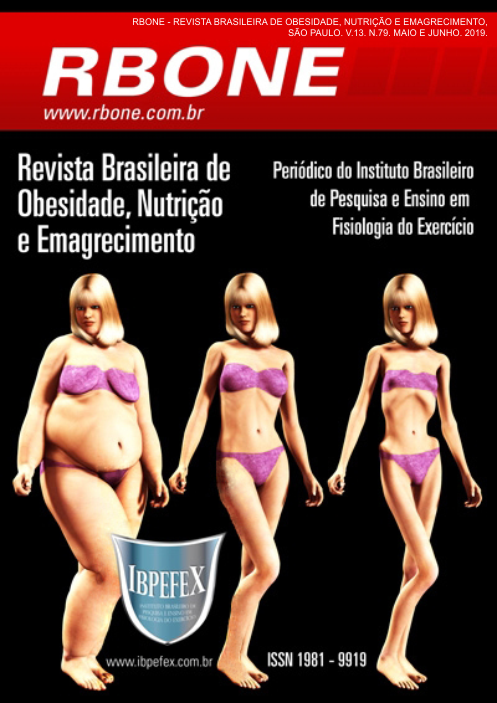Comorbities associated with obesity in patients candidate to bariatric surgery
Abstract
Introduction: The so-called contemporary Western lifestyle, marked by increased food consumption and decreased physical exercise, has led to the rise of a new epidemic: obesity. It is associated with several comorbidities, such as cardiovascular diseases, cancer, insulin resistance, among others. Objective: To analyze the prevalence of comorbidities present in obese patients who are candidates for bariatric surgery. Methods: This is a cross-sectional, retrospective and descriptive study, based on the database provided by the Nutrition Outpatient Clinic, in the Centro Universitário Assis Gurgacz (FAG), attended by SUS. Results: Among the 230 patients who were candidates for bariatric surgery, the majority belonged to the female gender (83%), the mean BMI of the patients was 47.6 ± 7.7kg / m² and the mean age was 46.1 ± 10.4 years. Systemic Arterial Hypertension (SAH) was the most common comorbidity (64.1%), as well as others such as Diabetes Mellitus type II (17.2%) and dyslipidemia (10.2%). Obesity type II was the range of BMIs with a relative number of hypertensive patients (74.1%), although Obesity type III obtained the highest absolute number of hypertensive patients (131). Discussion: In a literature review, they also reported SAH as the most common comorbidity in their study. Conclusion: It was observed that the most prevalent pathology, as in other previous studies, was Systemic Arterial Hypertension. In addition, the intimate relationship between obesity and the onset of such pathologies was noted.
References
-Bordalo, L.; Teixeira, T. F. S.; Bressan, J.; Mourão, D. M. Cirurgia bariátrica: como e por que suplementar. Revista da Associação Médica Brasileira. Vol. 57. Num. 1. p. 113-120. 2011.
-Brandão, I.; Pinho, A.N.; Arrojado, F.; Pinto-bastos, A.; Costa, J.M.; Coelho, R.; Calhau, C.; Conceição, E. Diabetes mellitus tipo 2, depressão e alterações do comportamento alimentar em doentes submetidos a cirurgia bariátrica. Revista Científica da Ordem dos Médicos. Vol. 29. Num. 3. p. 176-181. 2016.
-Brasil. Ministério da saúde. Vigitel brasil 2014: vigilância de fatores de risco e proteção para doenças crônicas por inquérito telefônico. Ministério da saúde, secretaria de vigilância em saúde, departamento de vigilância de doenças e agravos não transmissíveis e promoção da saúde. Brasília. 2015.
-Da Silva, C.D.A.; Figueira, M.A.; Maciel, M.C.S.P.G.; Gonçalves, l.R.; Sanchez, F.F. Perfil clínico de pacientes candidatos à cirurgia bariátrica. RBONE-Revista Brasileira de Obesidade, Nutrição e Emagrecimento. São Paulo. Vol. 11. Num. 64. p. 211-216. 2017. Disponível em: <http://www.rbone.com.br/index.php/rbone/article/view/521>
-Garcez, M.R.; Pereira, J.L.; Fontanelli, M.M.; Marchioni, D.M.L.; Fisberg, R.M. Prevalência de dislipidemia segundo estado nutricional em amostra representativa de São Paulo. Arquivos brasileiros de cardiologia. Vol. 103. Num. 6. p. 476-484. 2014.
-Gigante, D.P.; Moura, E.C.; Sardinha, l.M.V. Prevalência de excesso de peso e obesidade e fatores associados, brasil, 2006. Revista de saúde pública. Vol. 43. Num. 2. p. 83-89. 2009.
-Lopes, D.T.P.; Bertevello, P.L.; Possani, A.M.; Ferregutti, F.M.; Campos, T. Avaliação dos parâmetros clínicos e antropométricos pré e pós-operatórios de pacientes submetidos à cirurgia bariátrica. Arquivos de Ciências Da Saúde. Vol. 24. Num. 1. p. 98-104. 2017.
-Luz, D. M. D.; Encarnação, J. N. Vantagens e desvantagens da cirurgia bariátrica para o tratamento da obesidade mórbida. RBONE-Revista Brasileira de Obesidade, Nutrição e Emagrecimento. São Paulo. Vol. 2. Num. 10. 2008. Disponível em: <http://www.rbone.com.br/index.php/rbone/article/view/99>
-Mahan, L.K; Escott-stump, S.; Raymond, J. L. Krause: alimentos, nutrição e dietoterapia. Rio de janeiro. Elsevier. 2012. p. 470.
-Oliveira, M. S.; Lima, E. F. A.; Leite, F. M. C.; Primo, C. C. Perfil do paciente obeso submetido à cirurgia bariátrica. Cogitare enfermagem. Vol. 18. Num. p. 1. 2013.
-Pedrosa, I.V.; Burgos, M.G.P.A.; Souza, N.C.; Morais, C.M. Aspectos nutricionais em obesos antes e após a cirurgia bariátrica. Revista Do Colégio Brasileiro De Cirurgiões. Vol. 36. Num. 4. p. 316-322. 2009.
-Pereira, R. A relação entre dislipidemia e diabetes mellitus tipo 2. Cadernos Unifoa. Vol. 6. Num. 17. p. 89-94. 2017.
-Sanches, G. D.; Gazoni, F. M.; Konishi, R. K.; Guimarães, H. P.; Vendrame, L. S.; Lopes, R. D. Cuidados intensivos para pacientes em pós-operatório de cirurgia bariátrica. Revista Brasileira de Terapia Intensiva. Vol. 19. Num. 2. p. 205-209. 2007.
-Tardido, A.P.; Falcão, M.C. O impacto da modernização na transição nutricional e obesidade. Revista Brasileira De Nutrição Clínica. Vol. 21. Num. 2. p. 117-124. 2006.
-Tavares, T.B.; Nunes, S. M.; Santos, M. O. Obesidade e qualidade de vida: revisão da literatura. Revista Médica De Minas Gerais. Vol. 20. Num. 3. p. 359-366. 2010.
Authors who publish in this journal agree to the following terms:
- Authors retain the copyright and grant the journal the right of first publication, with work simultaneously licensed under the Creative Commons Attribution License BY-NC which allows the sharing of the work with acknowledgment of the authorship of the work and initial publication in this journal.
- Authors are authorized to enter into additional contracts separately for non-exclusive distribution of the version of the work published in this journal (eg, publishing in institutional repository or book chapter), with acknowledgment of authorship and initial publication in this journal.
- Authors are allowed and encouraged to post and distribute their work online (eg, in institutional repositories or on their personal page) at any point before or during the editorial process, as this can bring about productive change as well as increase impact and impact. citation of published work (See The Effect of Free Access).






